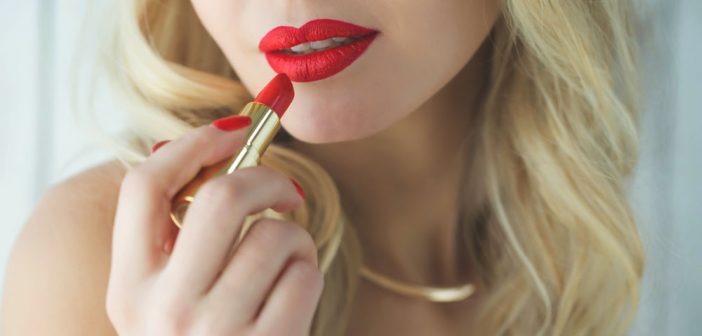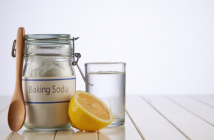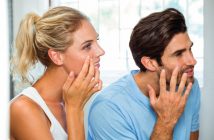Walking down the makeup aisle can be overwhelming. There are multiple brands of lipstick, and each brand has a slightly different shade available. Then factor in different lipstick formulas, and you may be tempted to leave without buying anything! Despite this process being tricky, once you find the right lipstick shade/formula, you’ll look and feel amazing. Follow these tips to help you find the perfect lipstick for your skin tone and tastes in a formula that’s right for you.
Skin Tones
Don’t try to match your lipstick to your clothes or hair color. Instead, look for a shade that complements your skin tone. If you don’t know your skin tone or undertones, there are a few tricks to help you decide.
Fair skin is pale and tends to burn easily without tanning. You might have some redness or some freckles on your skin.
Light skin also burns easily, but will usually tan after the initial burn.
Medium skin generally tans easily and doesn’t burn. It’s also rarely sensitive, although that isn’t a hard and fast rule.
Tan skin is darker than medium and may be considered olive in some cases. It can look slightly tanned, even when you haven’t been in the sun.
Dark skin is usually a few shades darker than tanned skin and rarely gets burned.
Undertones
Now that you know your skin tone, it’s time to determine your undertones. A simple way to determine if you are cool, warm, or neutral is to look at the veins on your wrist.
If the veins are purple or blue, you have a cool undertone. While if you see greener veins, you have more warm undertones. If it’s hard to tell if you see green or blue veins, then you probably have what’s known as a neutral skin tone. You can usually wear makeup for either warm or cool undertones. Olive skin tends to have more a more neutral undertone.
Complimentary Colors
Light or fair skin generally looks best in coral, peach, beige, nude, or light pink. Try a nude or a lighter mocha coffee shade if you have cool undertones. Warm undertones look best in pink or a nude lipstick with a hint of peach.
Medium skin tones should look for berry, mauve, or rose shades of lipstick. Cool undertones look best in cranberry or pink, but warm undertones look great in bronze or even copper.
For those with tan skin, look for lipstick shades with orange in them like coral. A dark pink also looks good. Avoid purple shades or brown shades because they don’t tend to be flattering for this skin tone.
If you have dark skin, darker colors like wine, caramel, walnut, and plum look best. For cool undertones, try wine or ruby colored. Warm undertones also look great in bronze.
Your skin tone and undertones should guide you, but they aren’t absolute measures. If you’re shopping, look at these shades and compare them to other colors. You may find that you love a different shade.
Natural Lipstick
If you’re looking for a natural lipstick for every day use, look for one that’s one or two shades darker than your natural shade.
To test how closely it matches your natural lip color, apply it to your bottom lip only. Close your lips and compare the top and bottom lips.
Make Lips Bigger or Smaller
Use lipstick to create an optical illusion to make your lips appear larger or smaller. Dark colors will make your lips look smaller, but light colors will make them look fuller.
Matte shades can also make lips look smaller. Use a gloss or a gloss finish for fuller looking lips.
Red Lipstick
Red lipstick can make a bold statement, but it’s one of the hardest colors to choose in the right shade. Once again, you’ll want to use your skin tone and undertones to find the right shade of red.
Fair or light skin look best with a red that’s more coral or pink. If you have cool skin, try a raspberry shade. Warm skin should look for a lipstick with a blueish undertone or even coral.
For tan or medium tones, look for a true red or bright red. Warm undertones can also look for a red with more orange in it. Cool undertones look best in a deeper wine-shade of red.
Dark skin tones with cool undertones look great in a deep ruby red or a dark wine color. For cool undertones, look for a red with some blue in it.
Shopping for Lipstick
Don’t go by the color on the packaging or in the bottle because it will look different on your skin. Try to go to a makeup store that has testers or samples available. They will have cotton swabs or other ways for you to test lipstick without the risk of germs.
When you do go shopping for lipstick, keep the rest of your makeup light. You want to make sure the lipstick doesn’t compete with your other products so you can focus on choosing the right shade.
Most makeup stores have good lighting, but you may want to walk outside in the sunlight to get a better idea of how you like the lipstick on you.
Lipstick Formulas
After you’ve chosen the right lipstick shade, you need to find the right formula.
Long Wearing
Sometimes called lip stains, these formulas last up to 8 hours or more. They are great if you don’t want to have to worry about reapplying your lipstick, but they can be drying if you use them daily.
Moisturizing
Moisturizing lipsticks are great for those with dry lips. They keep your lips smooth all day, but they are shiny and usually don’t last very long.
Sheer
Sheer lipsticks have a light color. The actual color also tends to be lighter than what it looks like in the packaging. They need to be reapplied often.
Matte
Matte lipsticks are available in a large variety of colors. They can be drying, so use a good lip balm when you’re not wearing your lipstick.
Cream
Cream lipsticks is between a matte and shiny, and it looks smooth on the lips. They are more moisturizing for the lips than other formulas.
Gloss
Glosses can be worn alone or layered with other lipsticks. They are great for every day wear to give a little depth to your lips.









